III-Nitride Short Period Superlattices for Deep UV Light Emitters
Abstract
Featured Application
Abstract
1. Introduction
2. Growth and Structural Characterization
3. Bandgap of AlN/AlGa(In)N SPSLs
4. AlN/AlGa(In)N SPSL Doping and Ohmic Contacts
5. Deep UV Light Emitters Based on AlN/AlGa(In)N SPSLs
6. Conclusions
Funding
Acknowledgments
Conflicts of Interest
References
- Alferov, Z.I. Nobel Lecture: The double heterostructure concept and its applications in physics, electronics, and technology. Rev. Mod. Phys. 2001, 73, 767–782. [Google Scholar] [CrossRef]
- Kroemer, H. Nobel Lecture: Quasielectric fields and band offsets: Teaching electrons new tricks. Rev. Mod. Phys. 2001, 73, 783–793. [Google Scholar] [CrossRef]
- Esaki, L.; Tsu, R. Superlattice and negative differential conductivity in semiconductors. IBM J. Res. Dev. 1970, 14, 61–65. [Google Scholar] [CrossRef]
- Casey, H.C., Jr.; Panish, M.B. Heterostructure Lasers; Academic Press: New York, NY, USA, 1978; pp. 156–300. ISBN 0-12-163102-8. [Google Scholar]
- Ivanov, S.V.; Kopev, P.S.; Ledentson, N.N.; Meltser, B.Y.; Nadtochy, M.Y.; Ustinov, V.M.; Vasilev, A.M. Ultrathin layers and short-period superlattices in semiconductor structures. Phys. Stat. Sol. 1990, 118, 169–177. [Google Scholar] [CrossRef]
- Chang, M.-H.; Das, D.; Varde, P.V.; Pecht, M. Light emitting diodes reliability review. Microelectron. Reliab. 2012, 52, 762–782. [Google Scholar] [CrossRef]
- Opel, D.R.; Hagstrom, E.; Pace, A.K.; Sisto, K.; Hirano-Ali, S.A.; Desai, S.; Swan, J. Light emitting diodes, a brief review and clinical experience. J. Clin. Aesthet. Dermatol. 2015, 8, 36–44. [Google Scholar] [PubMed] [PubMed Central]
- Yadav, A.; Titkov, I.E.; Sokolovskii, G.S.; Karpov, S.Y.; Dudelev, V.V.; Soboleva, K.K.; Strassburg, M.; Pietzonka, I.; Lugauer, H.-J.; Rafailov, E.U. AlGaInP red-emitting light emitting diode under extremely high pulsed pumping. Proc. SPIE 2016, 9768. [Google Scholar] [CrossRef]
- Karpov, S.Y. Light-emitting diodes for solid-state lighting: Searching room for improvements. Proc. SPIE 2016, 9768. [Google Scholar] [CrossRef]
- Gupta, S.D. (Ed.) Light Emitting Diodes for Agriculture; Springer: Singapore, 2017. [Google Scholar] [CrossRef]
- Schubert, E.F. Light-Emitting Diodes, 3rd ed.; Rensselaer Polytechnic Institute Troy: New York, NY, USA, 2018; pp. 17-1–17-15, 19-6–19-16, 21-2–21-8. ISBN 978-0-9863826-6-6. [Google Scholar]
- Pantha, B.N.; Dahal, R.; Nakarmi, M.L.; Nepal, N.; Li, J.; Lin, J.Y.; Jiang, H.X.; Paduano, Q.S.; Weyburne, D. Correlation between optoelectronic and structural properties and epilayer thickness of AlN. Appl. Phys. Lett. 2007, 90. [Google Scholar] [CrossRef]
- Zhou, C.; Ghods, A.; Saravade, V.G.; Patel, P.V.; Yunghans, K.L.; Ferguson, C.; Feng, Y.; Kucukgok, B.; Lu, N.; Ferguson, I.T. Review—The current and emerging applications of the III-Nitrides. ECS J. Sol. Stat. Sci. Technol. 2017, 6, Q-149–Q-156. [Google Scholar] [CrossRef]
- Davydov, V.Y.; Klochikhin, A.A.; Emtsev, V.V.; Kurdyukov, D.A.; Ivanov, S.V.; Vekshin, V.V.; Bechstedt, F.; Furthmüller, J.; Aderhold, J.; Graul, J.; et al. Band gap of hexagonal InN and InGaN alloys. Phys. Stat. Sol. 2002, 234, 787–795. [Google Scholar] [CrossRef]
- Wu, J.; Walukiewicz, W.; Shan, W.; Yu, K.M.; Ager, J.W., III; Li, S.X.; Haller, E.E.; Lu, H.; Schaff, W.J. Temperature dependence of the fundamental band gap of InN. J. Appl. Phys. Lett. 2003, 94, 4457–4460. [Google Scholar] [CrossRef]
- Andreev, B.A.; Kudryavtsev, K.E.; Yablonskiy, A.N.; Lobanov, D.N.; Bu shuykin, P.A.; Krasilnikova, L.V.; Skorokhodov, E.V.; Yunin, P.A.; Novikov, A.V.; Davydov, V.Y.; Krasilnik, Z.F. Towards the indium nitride laser: Obtaining infrared stimulated emission from planar monocrystalline InN structures. Sci. Rep. 2018, 8. [Google Scholar] [CrossRef] [PubMed]
- Akasaki, I. Nobel Lecture: Fascinated journeys into blue light. Rev. Mod. Phys. 2015, 87, 1119–1131. [Google Scholar] [CrossRef]
- Amano, H. Nobel Lecture: Growth of GaN on sapphire via low-temperature deposited buffer layer and realization of p-type GaN by Mg doping followed by low-energy electron beam irradiation. Rev. Mod. Phys. 2015, 87, 1133–1138. [Google Scholar] [CrossRef]
- Nakamura, S. Nobel Lecture: Background story of the invention of efficient blue InGaN light emitting diodes. Rev. Mod. Phys. 2015, 87, 1139–1151. [Google Scholar] [CrossRef]
- Kipshidze, G.; Kuryatkov, V.; Borisov, B.; Holtz, M.; Nikishin, S.; Temkin, H. AlGaInN light-emitting diodes grown on Si (111). Appl. Phys. Lett. 2002, 80, 3682–3684. [Google Scholar] [CrossRef]
- Sizov, V.S.; Tsatsulnikov, A.F.; Sakharov, A.V.; Lundin, W.V.; Zavarin, E.E.; Cherkashin, N.A.; Hÿtch, M.J.; Nikolaev, A.E.; Mintairov, A.M.; He, Y.; et al. The use of short_period InGaN/GaN superlattices in blue-region light-emitting diodes. Semiconductors 2010, 44, 924–930. [Google Scholar] [CrossRef]
- Lähnemann, J.; Ajay, A.; Den Hertog, M.I.; Monroy, E. Near-infrared intersubband photodetection in GaN/AlN nanowires. Nano Lett. 2017, 17, 6954–6960. [Google Scholar] [CrossRef] [PubMed]
- Mehta, K.; Liu, Y.-S.; Wang, J.; Jeong, H.; Detchprohm, T.; Park, Y.J.; Alugubelli, S.R.; Wang, S.; Ponce, F.A.; Shen, S.-C.; et al. Lateral current spreading in III-N ultraviolet vertical-cavity surface-emitting lasers using modulation-doped short period superlattices. IEEE J. Quant. Electron. 2018, 54. [Google Scholar] [CrossRef]
- Nikishin, S.A.; Faleev, N.N.; Antipov, V.G.; Francoeur, S.; Grave de Peralta, L.; Seryogin, G.A.; Temkin, H.; Prokofyeva, T.I.; Holtz, H.; Chu, S.N.G. High quality GaN grown on Si(111) by gas source molecular beam epitaxy with ammonia. Appl. Phys. Lett. 1999, 75, 2073–2075. [Google Scholar] [CrossRef]
- Nikishin, S.; Kipshidze, G.; Kuryatkov, V.; Zubrilov, A.; Choi, K.; Gherasoiu, Iu.; Grave de Peralta, L.; Prokofyeva, T.; Holtz, M.; Asomoza, R.; et al. Gas source molecular beam epitaxy of high quality AlGaN on Si and sapphire. Mat. Res. Soc. Symp. 2001, 639. [Google Scholar] [CrossRef]
- Xiao, M.; Zhang, J.; Hao, Y. High-quality Ga-rich AlGaN grown on trapezoidal patterned GaN template using super-short period AlN/GaN superlattices for rapid coalescence. J. Cryst. Growth 2017, 464, 153–158. [Google Scholar] [CrossRef]
- Aumer, M.E.; LeBoeuf, S.F.; Bedairb, S.M.; Smith, M.; Lin, J.Y.; Jiang, H.X. Effects of tensile and compressive strain on the luminescence properties of AlInGaN/InGaN quantum well structures. Appl. Phys. Lett. 2000, 77, 821–823. [Google Scholar] [CrossRef]
- Son, J.H.; Lee, J.-L. Strain engineering for the solution of efficiency droop in InGaN/GaN light-emitting diodes. Opt. Express 2010, 18, 5466–5471. [Google Scholar] [CrossRef] [PubMed]
- Nakamura, S.; Fasol, G. The Blue Laser Diode; Springer: Berglin/Heidelberg, Germany; New York, NY, USA, 1997; pp. 147–300. ISBN 978-3-662-03464-4 or 978-3-662-03462-0. [Google Scholar]
- Morkoç, H. Handbook of Nitride Semiconductors and Devices. V.3: GaN-Based Optical and Electronic Devices; WILEY-VCH Verlag GmbH & Co. KGaA: Weinheim, Germany, 2009; pp. 4–334. ISBN 978-3-527-40839-9. [Google Scholar]
- Kneissl, M.; Rass, J. III-Nitride Ultraviolet Emitters Technology and Applications; Springer Series in Materials Science; Springer: Berglin/Heidelberg, Germany, 2016; Volume 227, pp. 3–12, 90–104. ISBN 978-3-319-24098-5. [Google Scholar]
- Amano, H. Progress and prospect of growth of wide-band-gap group III Nitrides. In III-Nitride Based Light Emitting Diodes and Applications, 2nd ed.; Seong, T.-Y., Han, J., Amano, H., Morkoç, H., Eds.; Springer: Singapore, 2017; pp. 1–9. ISBN 978-981-10-3754-2. [Google Scholar]
- Egawa, T.; Oda, O. LEDs based on hetero epitaxial GaN on Si substrates. In III-Nitride Based Light Emitting Diodes and Applications, 2nd ed.; Seong, T.-Y., Han, J., Amano, H., Morkoç, H., Eds.; Springer: Singapore, 2017; pp. 1–9. ISBN 978-981-10-3754-2. [Google Scholar]
- Tadatomo, K.; Okagawa, H.; Ohuchi, Y.; Tsunekawa, T.; Kudo, H.; Sudo, Y.; Kato, M.; Taguchi, T. High output power near-ultraviolet and violet light-emitting diodes fabricated on patterned sapphire substrates using metalorganic vapor phase epitaxy. J. Light Vis. Env. 2003, 27, 140–145. [Google Scholar] [CrossRef]
- Kneissl, M.; Rass, J.; Schade, L.; Schwarz, U.T. Growth and Optical Properties of GaN-Based Non- and Semipolar LEDs. In III-Nitride Based Light Emitting Diodes and Applications, 2nd ed.; Seong, T.-Y., Han, J., Amano, H., Morkoç, H., Eds.; Springer: Singapore, 2017; pp. 93–128. ISBN 978-981-10-3754-2. [Google Scholar]
- Hirayama, H.; Kamata, N.; Tsubaki, K. AlGaN-Based Deep-Ultraviolet Light-Emitting Diodes. In III-Nitride Based Light Emitting Diodes and Applications, 2nd ed.; Seong, T.-Y., Han, J., Amano, H., Morkoç, H., Eds.; Springer: Singapore, 2017; pp. 93–128. ISBN 978-981-10-3754-2. [Google Scholar]
- Staszczak, G.; Gorczyca, I.; Grzank, E.; Smalc-Koziorowska, J.; Targowski, G.; Czernecki, R.; Siekacz, M.; Grzanka, S.; Skierbiszewski, C.; Schulz, T.; et al. Bandgap behavior of InGaN/GaN short period superlattices grown by metal-organic vapor phase epitaxy. Phys. Stat. Sol. 2017, 254, 1600710. [Google Scholar] [CrossRef]
- Dimitrakopulos, G.P.; Vasileiadis, I.G.; Bazioti, C.; Smalc-Koziorowska, J.; Kret, S.; Dimakis, E.; Florini, N.; Kehagias, T.; Suski, T.; Karakostas, T.; et al. Compositional and strain analysis of In(Ga)N/GaN short period superlattices. J. Appl. Phys. 2018, 123, 024304. [Google Scholar] [CrossRef]
- Gorczyca, I.; Suski, T.; Christensen, N.E.; Svane, A. Theoretical study of nitride short period superlattices. J. Phys. Condens. Matter 2018, 30, 063001. [Google Scholar] [CrossRef] [PubMed]
- Lundin, W.V.; Nikolaev, A.E.; Sakharov, A.V.; Zavarin, E.E.; Valkovskiy, G.A.; Yagovkina, M.A.; Usov, S.O.; Kryzhanovskaya, N.V.; Sizov, V.S.; Brunkov, P.N.; et al. Single quantum well deep-green LEDs with buried InGaN/GaN short-period superlattice. J. Cryst. Growth 2011, 315, 267–271. [Google Scholar] [CrossRef]
- Kipshidze, G.; Kuryatkov, V.; Borisov, B.; Nikishin, S.; Holtz, M.; Chu, S.N.G.; Temkin, H. Deep Ultraviolet AlGaInN-Based Light-Emitting Diodes on Si(111) and Sapphire. Phys. Stat. Sol. 2002, 192, 286–291. [Google Scholar] [CrossRef]
- Kipshidze, G.; Kuryatkov, V.; Zhu, K.; Borisov, B.; Holtz, M.; Nikishin, S.; Temkin, H. AlN/AlGaInN superlattice light emitting diodes at 280 nm. J. Appl. Phys. 2003, 93, 1363–1366. [Google Scholar] [CrossRef]
- Jmerik, V.N.; Lutsenko, E.V.; Ivanov, S.V. Plasma-assisted molecular beam epitaxy of AlGaN heterostructures for deep-ultraviolet optically pumped lasers. Phys. Stat. Sol. 2013, 210, 439–450. [Google Scholar] [CrossRef]
- Shatalov, M.; Sun, W.; Jain, R.; Lunev, A.; Hu, X.; Dobrinsky, A.; Bilenko, Yu.; Yang, J.; Garrett, G.A.; Rodak, L.E.; et al. High power AlGaN ultraviolet light emitters. Semicond. Sci. Technol. 2014, 29, 084007. [Google Scholar] [CrossRef]
- Nikishin, S.A.; Holtz, M.; Temkin, H. Digital alloys AlN/AlGaN for deep UV light emitting diodes. Jpn. J. Appl. Phys. 2005, 44, 7221–7226. [Google Scholar] [CrossRef]
- Sun, W.; Tan, C.-K.; Tansu, N. AlN/GaN Digital alloy for mid- and deep-ultraviolet optoelectronics. Sci. Rep. 2017, 7, 11826–11833. [Google Scholar] [CrossRef] [PubMed]
- Gorczyca, I.; Suski, T.; Strak, P.; Staszczak, G.; Christensen, N.E. Band gap engineering of In(Ga)N/GaN short period superlattices. Sci. Rep. 2017, 7, 16055. [Google Scholar] [CrossRef] [PubMed]
- Kaneko, M.; Ueta, S.; Horita, M.; Kimoto, T.; Suda, J. Deep-ultraviolet light emission from 4H-AlN/4H-GaN short-period superlattice grown on 4H-SiC (11–20). Appl. Phys. Lett. 2018, 112, 012106. [Google Scholar] [CrossRef]
- Neave, J.H.; Joyce, B.A.; Dobson, P.J.; Norton, N. Dynamics of films growth of GaAs by MBE from RHEED observations. Appl. Phys. A 1983, 31, 1–8. [Google Scholar] [CrossRef]
- Yang, Z.; Li, L.K.; Wang, W.I. High-quality GaN and AlN grown by gas-source molecular beam epitaxy using ammonia as the nitrogen source. J. Vac. Sci. Technol. B 1996, 14, 2354–2356. [Google Scholar] [CrossRef]
- Grandjean, N.; Massies, J. GaN and AlxGa1−xN molecular beam epitaxy monitored by reflection high-energy electron diffraction. Appl. Phys. Lett. 1997, 71, 1816–1818. [Google Scholar] [CrossRef]
- Daudin, B.; Widmann, F. Layer-by-layer grown of AlN and GaN by molecular beam epitaxy. J. Cryst. Growth 1997, 182, 1–5. [Google Scholar] [CrossRef]
- Nikishin, S.A.; Borisov, B.A.; Chandolu, A.; Kuryatkov, V.V.; Temkin, H.; Holtz, M.; Mokhov, E.N.; Makarov, Y.; Helava, H. Short period superlattices of AlN/Al0.08Ga0.92N grown on AlN substrates. Appl. Phys. Lett. 2004, 85, 4355–4357. [Google Scholar] [CrossRef]
- Borisov, B.; Nikishin, S.; Kuryatkov, V.; Temkin, H. Enhanced deep ultraviolet luminescence from AlGaN quantum wells grown in the three dimensional mode. Appl. Phys. Lett. 2005, 87, 191902. [Google Scholar] [CrossRef]
- Borisov, B.A.; Nikishin, S.A.; Kuryatkov, V.V.; Kuchinski, V.I.; Holtz, M.; Temkin, H. Enhanced radiative recombination in AlGaN quantum wells grown by molecular-beam epitaxy. Semiconductors 2006, 40, 454–458. [Google Scholar] [CrossRef]
- Panish, M.B.; Temkin, H. Gas Source Molecular Beam Epitaxy. Growth and Properties of Phosphorus Containing III–V Heterostructures; Springer Series in Materials Science; Springer: Berlin/Heidelberg, Germany, 1993; Volume 26, pp. 115–230. ISBN 3-540-56540-X (Berlin) or 0-387-56540-X (New York). [Google Scholar]
- Nikishin, S.A.; Borisov, B.A.; Garrett, G.A.; Sarney, W.L.; Sampath, A.V.; Shen, H.; Wraback, M.; Holtz, M. Enhanced luminescence from AlxGa1−xN/AlyGa1−yN quantum wells grown by gas source molecular beam epitaxy with ammonia. Proc. SPIE 2007, 6473, 647306. [Google Scholar]
- Nikishin, S.A.; Borisov, B.A.; Kuryatkov, V.V.; Holtz, M.; Garrett, G.A.; Sarney, W.L.; Sampath, A.V.; Shen, H.; Wraback, M. Correlations between the growth modes and luminescence properties of AlGaN quantum structures. Jpn. J. Appl. Phys. 2008, 47, 1556–1558. [Google Scholar] [CrossRef]
- Islam, S.M.; Lee, K.; Verma, J.; Protasenko, V.; Rouvimov, S.; Bharadwaj, S.; Xing, H.G.; Jena, D. MBE-grown 232–270 nm deep-UV LEDs using monolayer thin binary GaN/AlN quantum heterostructures. Appl. Phys. Lett. 2017, 110, 041108. [Google Scholar] [CrossRef]
- Islam, S.M.; Protasenko, V.; Lee, K.; Rouvimov, S.; Verma, J.; Xing, H.G.; Jena, D. Deep-UV emission at 219 nm from ultrathin MBE GaN/AlN quantum heterostructures. Appl. Phys. Lett. 2017, 111, 091104. [Google Scholar] [CrossRef]
- Chandolu, A.; Nikishin, S.; Holtz, M.; Temkin, H. X-ray diffraction study of AlN/AlGaN short-period superlattices. J. Appl. Phys. 2007, 102, 114909. [Google Scholar] [CrossRef]
- Kandaswamy, P.K.; Guillot, F.; Bellet-Amalric, E.; Monroy, E.; Nevou, L.; Tchernycheva, M.; Michon, A.; Julien, F.H.; Baumann, E.; Giorgetta, F.R.; et al. GaN/AlN short-period superlattices for intersubband optoelectronics: A systematic study of their epitaxial growth, design, and performance. J. Appl. Phys. 2008, 104, 093501. [Google Scholar] [CrossRef]
- Kladko, V.; Kuchuk, A.; Lytvyn, P.; Yefanov, O.; Safriuk, N.; Belyaev, A.; Mazur, Y.I.; DeCuir, E.A., Jr.; Ware, M.E.; Salamo, G.J. Substrate effects on the strain relaxation in GaN/AlN short-period superlattices. Nanoscale Res. Lett. 2012, 7, 289. [Google Scholar] [CrossRef] [PubMed]
- Noh, Y.-K.; Seo, J.-H.; Choi, H.-S.; Kim, M.-D.; Oh, J.-E. Thickness dependence of temperature-induced emission mechanism in InGaN/AlGaN short-period superlattices. J. Appl. Phys. 2012, 112, 043102. [Google Scholar] [CrossRef]
- Kutt, R.N.; Shcheglov, M.P.; Ratnikov, V.V.; Yagovkina, M.A.; Davydov, V.Y.; Smirnov, A.N.; Rozhavskaya, M.M.; Zavarin, E.E.; Lundin, V.V. X-ray diffraction study of short-period AlN/GaN superlattices. Crystallogr. Rep. 2013, 58, 953–958. [Google Scholar] [CrossRef]
- Pinquier, C.; Frandon, J.; Demangeot, F.; Smirnov, M.; Sarua, A.; Kuball, M.; Monroy, E.; Daudin, B. Behavior of phonons in short-period GaN-AlN superlattices. Phys. Stat. Sol. 2004, 1, 2706–2710. [Google Scholar] [CrossRef]
- Davydov, V.Yu.; Roginskii, E.M.; Smirnov, A.N.; Kitaev, Y.E.; Yagovkina, M.A.; Kyutt, R.N.; Rozhavskaya, M.M.; Zavarin, E.E.; Lundin, W.V.; Smirnov, M.B. Lattice dynamics of short-period AlN/GaN short period superlattices: Theory and experiments. Phys. Stat. Sol. 2013, 210, 484–487. [Google Scholar] [CrossRef]
- Pankin, D.V.; Smirnov, M.B.; Davydov, V.Y.; Smirnov, A.N.; Zavarin, E.E.; Lundin, W.V. Elastic Strains and Delocalized Optical Phonons in AlN/GaN Superlattices. Semiconductors 2016, 50, 1043–1048. [Google Scholar] [CrossRef]
- Sarkar, K.; Datta, D.; Gosztola, D.J.; Shi, F.; Nicholls, A.; Stroscio, M.A.; Dutta, M. Raman analysis of phonon modes in a short period AlN/GaN superlattice. Superlattices Microstruct. 2018, 115, 116–122. [Google Scholar] [CrossRef]
- Stolyarchuk, N.; Markurt, T.; Courville, A.; March, K.; Tottereau, O.; Vennéguès, P.; Albrecht, M. Impact of sapphire nitridation on formation of Al-polar inversion domains in N-polar AlN epitaxial layers. J. Appl. Phys. 2017, 122, 155303. [Google Scholar] [CrossRef]
- Schuck, P.J.; Mason, M.D.; Grober, R.D.; Ambacher, O.; Lima, A.P.; Miskys, C.; Dimitrov, R.; Stutzmann, M. Spatially resolved photoluminescence of inversion domain boundaries in GaN-based lateral polarity heterostructures. Appl. Phys. Lett. 2001, 79, 952–954. [Google Scholar] [CrossRef]
- Shubina, T.V.; Jmerik, V.N.; Tkachman, M.G.; Vekshin, V.A.; Ratnikov, V.V.; Toropov, A.A.; Sitnikova, A.A.; Ivanov, S.V.; Bergman, J.P.; Karlsson, F.; et al. Nanometric-scale fluctuations of intrinsic electric fields in GaN/AlGaN quantum wells with inversion domains. Phys. Stat. Sol. 2002, 234, 919–923. [Google Scholar] [CrossRef]
- SiLENSe—Software Tool for Light Emitting Diode (LED) Bandgap Engineering. Available online: https://na01.safelinks.protection.outlook.com/?url=http%3A%2F%2Fwww.str-soft.com%2Fproducts%2FSiLENSe%2Findex.htm&data=02%7C01%7CSergey.A.Nikishin%40ttu.edu%7C1b70d2ef115047f2580008d622bf3be0%7C178a51bf8b2049ffb65556245d5c173c%7C0%7C0%7C636734602099986989&sdata=YpequeQnoIjnZ5cNklA7U5Zts7E%2FGL0Jz%2F1oAfZEdX4%3D&reserved=0 (accessed on 22 November 2018).
- Crosslight Software Inc. Available online: https://na01.safelinks.protection.outlook.com/?url=https%3A%2F%2Fcrosslight.com%2F&data=02%7C01%7CSergey.A.Nikishin%40ttu.edu%7C1b70d2ef115047f2580008d622bf3be0%7C178a51bf8b2049ffb65556245d5c173c%7C0%7C0%7C636734602099986989&sdata=vCC9BOBAXHLNXsh6KhW1CvooXSMJOC2KdKHyv77BAjI%3D&reserved=0 (accessed on 22 November 2018).
- Synopsys, Inc. Available online: https://na01.safelinks.protection.outlook.com/?url=https%3A%2F%2Fwww.synopsys.com%2F&data=02%7C01%7CSergey.A.Nikishin%40ttu.edu%7C1b70d2ef115047f2580008d622bf3be0%7C178a51bf8b2049ffb65556245d5c173c%7C0%7C0%7C636734602099986989&sdata=33YOp0jlN06RqaUg2AIjE6oOB2OH%2Bi%2BNnzafC3Y2lgM%3D&reserved=0 (accessed on 22 November 2018).
- Bandgap Engineering Superlattice Simulation Tool (BESST)—Package for Simulation of Optoelectronic Devices Based on Group-III Nitride superlattices. Available online: http://www.str-soft.com/products/BESST/index.htm (accessed on 22 November 2018).
- Kozodoy, P.; Hansen, M.; DenBaars, S.P.; Mishra, U.K. Enhanced Mg doping efficiency in Al0.2Ga0.8N/GaN superlattices. Appl. Phys. Lett. 1999, 74, 3681–3683. [Google Scholar] [CrossRef]
- Bulashevich, K.A.; Karpov, S.Y. Heterojunctions between group-III nitride short period superlattices. Phys. Stat. Sol. 2005, 2, 2394–2398. [Google Scholar] [CrossRef]
- Holtz, M.; Prokofyeva, T.; Seon, M.; Copeland, K.; Vanbuskirk, J.; Williams, S.; Nikishin, S.; Tretyakov, V.; Temkin, H. Composition dependence of the optical phonon energies in hexagonal AlxGa1−xN. J. Appl. Phys. 2001, 89, 7977–7982. [Google Scholar] [CrossRef]
- Kuryatkov, V.; Chandolu, A.; Borisov, B.; Kipshidze, G.; Zhu, K.; Nikishin, S.; Temkin, H.; Holtz, M. Solar-blind ultraviolet photodetectors based on superlattices of AlN/AlGa(In)N. Appl. Phys. Lett. 2003, 82, 1323–1325. [Google Scholar] [CrossRef]
- Herzog, J.B.; Mintairov, A.M.; Sun, K.; Cao, Y.; Jena, D.; Merz, J.L. Infrared reflectivity spectroscopy of optical phonons in short-period AlGaN/GaN superlattices. Proc. SPIE 2007, 6648, 664803. [Google Scholar]
- Marx, G.; Engelbrecht, J.A.A.; Lee, M.E.; Wagener, M.C.; Henry, A. Comments on a peak of AlxGa1−xN observed by infrared reflectance. Infrared Phys. Technol. 2016, 76, 493–499. [Google Scholar] [CrossRef]
- Pendlebury, S.T.; Lynam, P.; Mowbray, D.J.; Parbrook, P.J.; Wood, D.A.; Lada, M.; O’Neill, J.P.; Cullis, A.G.; Skolnick, M.S. Optical characterization of AlGaN epitaxial layers and GaN/AlGaN quantum wells. Phys. Stat. Sol. 2001, 188, 871–875. [Google Scholar] [CrossRef]
- Adelmann, C.; Sarigiannidou, E.; Jalabert, D.; Hori, Y.; Rouvière, J.-L.; Daudin, B.; Fanget, S.; Bru-Chevallier, C.; Shibata, T.; Tanaka, M. Growth and optical properties of GaN/AlN quantum wells. Appl. Phys. Lett. 2003, 82, 4154–4156. [Google Scholar] [CrossRef]
- Paskov, P.; Monemar, B.; Kamyiama, S.; Amano, H.; Akasaki, I. Optical Properties of undoped, n-doped and p-doped GaN/AlN superlattices. Mater. Res. Soc. Symp. Proc. 2007, 955, 0955-I12-03. [Google Scholar] [CrossRef]
- Da-Bing, L.; Wei-Guo, H.; Hideto, M.; Kazumasa, H.; Hang, S. Enhanced deep ultraviolet emission from Si-doped AlxGa1−xN/AlN MQWs. Chin. Phys. B 2010, 19, 127891. [Google Scholar] [CrossRef]
- Borisov, B.; Kuryatkov, V.; Kudryavtsev, Y.; Asomoza, R.; Nikishin, S.; Holtz, M.; Temkin, H. Si-doped AlxGa1−xN (0.56 ≤ x ≤ 1) layers grown by molecular beam epitaxy with ammonia. Appl. Phys. Lett. 2005, 87, 132106–132108. [Google Scholar] [CrossRef]
- Taniyasu, Y.; Kasu, M.; Toshiki Makimoto, T. Electrical conduction properties of n-type Si-doped AlN with high electron mobility (>100 cm2 V−1 s−1). Appl. Phys. Lett. 2004, 85, 4672–4674. [Google Scholar] [CrossRef]
- Contreras, S.; Konczewicz, L.; Messaoud, J.B.; Peyre, H.; Khalfioui, M.A.; Matta, S.; Leroux, M.; Damilano, B.; Brault, J. High temperature electrical transport study of Si-doped AlN. Superlattices Microstruct. 2016, 98, 253–258. [Google Scholar] [CrossRef]
- Pampili, P.; Parbrook, P.J. Doping on III-nitride materials. Mat. Sci. Semicond. Proc. 2017, 62, 180–191. [Google Scholar] [CrossRef]
- Nikishin, S.A.; Kuryatkov, V.V.; Chandolu, A.; Borisov, B.A.; Kipshidze, G.D.; Ahmad, I.; Holtz, M.; Temkin, H. Deep ultraviolet light emitting diodes based on short period superlattices of AlN/AlGa(In)N. Jpn. J. Appl. Phys. 2003, 42, L1362–L1365. [Google Scholar] [CrossRef]
- Yun, J.; Choi, K.; Mathur, K.; Kuryatkov, V.; Borisov, B.; Kipshidze, G.; Nikishin, S.; Temkin, H. Low resistance ohmic contacts to digital alloys of n-AlGaN/AlN. IEEE Electron Device Lett. 2006, 27, 22–24. [Google Scholar] [CrossRef]
- Kozodoy, P.; Xing, H.; DenBaars, S.P.; Mishra, U.K.; Saxler, A.; Perrin, R.; Elhamri, S.; Mitchel, W.C. Heavy doping effects in Mg-doped GaN. J. Appl. Phys. 2000, 87, 1832–1835. [Google Scholar] [CrossRef]
- Jiang, X.-H.; Shi, J.-J.; Zhang, M.; Zhong, H.-X.; Huang, P.; Ding, Y.-M.; He, Y.-P.; Cao, X. Reduction of the Mg acceptor activation energy in GaN, AlN, Al0.83Ga0.17N and MgGa δ-doping (AlN)5/(GaN)1: The strain effect. J. Phys. D Appl. Phys. 2015, 48, 475104. [Google Scholar] [CrossRef]
- Nam, K.B.; Nakarmi, M.L.; Li, J.; Lin, J.Y.; Jiang, H.X. Mg acceptor level in AlN probed by deep ultraviolet photoluminescence. Appl. Phys. Lett. 2003, 83, 878–880. [Google Scholar] [CrossRef]
- Liang, Y.-H.; Towe, E. Progress in efficient doping of high aluminum-containing group III-nitrides. Appl. Phys. Rev. 2018, 5, 011107. [Google Scholar] [CrossRef]
- Ilegems, M.; Dingle, R. Luminescence of Mg- and Be- doped GaN. J. Appl. Phys. 1973, 44, 4234–4235. [Google Scholar] [CrossRef]
- Gelhausen, O.; Phillips, M.R.; Goldys, E.M.; Paskova, T.; Monemar, B.; Strassburg, M.; Hoffmann, A. Dissociation of H-related defect complexes in Mg-doped GaN. Phys. Rev. B 2004, 69, 125210. [Google Scholar] [CrossRef]
- Amano, H.; Kito, M.; Hiramatsu, K.; Akasaki, I. P-type conduction in Mg-doped GaN treated with low-energy electron beam irradiation (LEEBI). Jpn. J. Appl. Phys. 1989, 28, L2112–L2114. [Google Scholar] [CrossRef]
- Chernyak, L.; Osinsky, A.; Fuflyigin, V.; Schubert, E.F. Electron beam-induced increase of electron diffusion length in -type GaN and AlGaN/GaN superlattices. Appl. Phys. Lett. 2000, 77, 875–877. [Google Scholar] [CrossRef]
- Phillips, M.R.; Merklein, M.; Hardy, T.; Manning, T.J.; Wintrebert-Fouquet, M. A mechanism for Mg acceptor activation in GaN by low energy electron beam irradiation. Microsc. Microanal. 2010, 16, 816–817. [Google Scholar] [CrossRef]
- Korotkov, R.Y.; Gregie, J.M.; Wessels, B.W. Electrical properties of p-type GaN:Mg codoped with oxygen. Appl. Phys. Lett. 2001, 78, 222–224. [Google Scholar] [CrossRef]
- Kipshidze, G.; Kuryatkov, V.; Borisov, B.; Kudryavtsev, Yu.; Asomoza, R.; Nikishin, S.; Temkin, H. Mg and O codoping in p-type GaN and AlxGa1−xN (0 < x < 0.08). Appl. Phys. Lett. 2002, 80, 2910–2912. [Google Scholar] [CrossRef]
- Wu, R.Q.; Shen, L.; Yang, M.; Sha, Z.D.; Cai, Y.Q.; Feng, Y.P.; Huang, Z.G.; Wu, Q.Y. Enhancing hole concentration in AlN by Mg:O codoping: Ab initio study. Phys. Rev. B 2008, 77, 073203. [Google Scholar] [CrossRef]
- Khan, M.A.; Adviarahan, V.; Zhang, J.P.; Chen, C.; Kuokstis, E.; Chitnis, A.; Shatalov, M.; Yang, J.W.; Simin, G. Stripe geometry ultraviolet light emitting diodes at 305 nanometers using quaternary AlInGaN multiple quantum wells. Jpn. J. Appl. Phys. 2001, 40, L1308–L1310. [Google Scholar] [CrossRef]
- Lopatiuk-Tirpak, O.; Chernyak, L.; Borisov, B.A.; Kuryatkov, V.V.; Nikishin, S.A.; Gartsman, K. Electron irradiation-induced increase of minority carrier diffusion length, mobility, and lifetime in Mg-doped AlN/AlGaN short period superlattice. Appl. Phys. Lett. 2007, 91, 182103. [Google Scholar] [CrossRef]
- Allerman, A.A.; Crawford, M.H.; Miller, M.A.; Lee, S.R. Growth and characterization of Mg-doped AlGaN-AlN short-period superlattices for deep-UV optoelectronic devices. J. Cryst. Growth 2010, 312, 756–761. [Google Scholar] [CrossRef]
- Nikishin, S.; Borisov, B.; Mansurov, V.; Pandikunta, M.; Chary, I.; Rajanna, G.; Bernussi, A.; Kudryavtsev, Y.; Asomoza, R.; Bulashevich, K.A.; et al. Short period p-type AlN/AlGaN superlattices for deep UV light emitters. Mater. Res. Soc. Symp. Proc. 2010, 1202, 1202-I10-03. [Google Scholar] [CrossRef]
- Shatalov, M.; Gaska, R.; Yang, J.; Shur, M. Method of Doping and Semiconductor Devices. U.S. Patent 8,426,225, 23 April 2013. [Google Scholar]
- Martens, M.; Kuhn, C.; Ziffer, E.; Simoneit, T.; Kueller, V.; Knauer, A.; Rass, J.; Wernicke, T.; Einfeldt, S.; Weyers, M.; et al. Low absorption loss p-AlGaN superlattice cladding layer for current-injection deep ultraviolet laser diodes. Appl. Phys. Lett. 2016, 108, 151108. [Google Scholar] [CrossRef]
- Suzuki, M.; Nishio, J.; Onomura, M.; Hongo, C. Doping characteristics and electrical properties of Mg-doped AlGaN grown by atmospheric-pressure MOCVD. J. Cryst. Growth 1998, 189/190, 511–515. [Google Scholar] [CrossRef]
- Li, J.; Oder, T.N.; Nakarmi, M.L.; Lin, J.Y.; Jiang, H.X. Optical and electrical properties of Mg-doped p-type AlxGa1−xN. Appl. Phys. Lett. 2002, 80, 1210–1212. [Google Scholar] [CrossRef]
- Taniyasu, Y.; Kasu, M.; Makimoto, T. An aluminium nitride light-emitting diode with a wavelength of 210 nanometres. Nature 2006, 441, 325–328. [Google Scholar] [CrossRef] [PubMed]
- Kinoshita, T.; Obata, T.; Yanagi, H.; Inoue, S.-I. High p-type conduction in high-Al content Mg-doped AlGaN. Appl. Phys. Lett. 2013, 102, 012105. [Google Scholar] [CrossRef]
- Dussaigne, A.; Damilano, B.; Brault, J.; Massies, J.; Feltin, E.; Grandjean, N. High doping level in Mg-doped GaN layers grown at low temperature. J. Appl. Phys. 2008, 103, 013110. [Google Scholar] [CrossRef]
- Chuang, S.L.; Chang, C.S. k·p method for strained wurtzite semiconductors. Phys. Rev. B 1996, 54, 2491–2504. [Google Scholar] [CrossRef]
- Blank, T.V.; Gol’dberg, Y.A. Mechanisms of current flow in metal-semiconductor ohmic contacts. Semiconductors 2007, 41, 1263–1292. [Google Scholar] [CrossRef]
- Ho, J.-K.; Jong, C.-S.; Chiu, C.C.; Huang, C.-N.; Shih, K.-K.; Chen, L.-C.; Chen, F.-R.; Kai, J.-J. Low-resistance ohmic contacts to p-type GaN achieved by the oxidation of Ni/Au films. J. Appl. Phys. 1999, 86, 4491. [Google Scholar] [CrossRef]
- Lim, S.-H.; Ra, T.-Y.; Kim, W.-Y. Interface observation in Au/Ni/p-GaN studies by HREM and energy-filtering TEM. J. Electron Microsc. 2003, 52, 459–464. [Google Scholar] [CrossRef]
- Qiao, D.; Yu, L.S.; Lau, S.S.; Lin, J.Y.; Jiang, H.X.; Haynes, T.E. A study of the Au/Ni ohmic contact on p-GaN. J. Appl. Phys. 2000, 88, 4196–4200. [Google Scholar] [CrossRef]
- Chary, I.; Chandolu, A.; Borisov, B.; Kuryatkov, V.; Nikishin, S.; Holtz, M. Influence of surface treatment and annealing temperature on the formation of low-resistance Au/Ni ohmic contacts to p-GaN. J. Electron. Mater. 2009, 38, 545–550. [Google Scholar] [CrossRef]
- Chary, I.; Borisov, B.; Kuryatkov, V.; Kudryavtsev, Y.; Asomoza, R.; Nikishin, S.; Holtz, M. Low resistance ohmic contacts to p-type GaN and AlGaN. Mater. Res. Soc. Symp. Proc. 2009, 1108, 1108-A09-30. [Google Scholar]
- Nikishin, S.; Chary, I.; Borisov, B.; Kuryatkov, V.; Kudryavtsev, Y.; Asomoza, R.; Karpov, S.Y.; Holtz, M. Mechanism of curriers injection in (Ni/Au)/p-AlxGa1−xN:Mg (0 ≤ x < 0.1) ohmic contacts. Appl. Phys. Lett. 2009, 95, 163502. [Google Scholar] [CrossRef]
- Nikishin, S.; Borisov, B.; Kuryatkov, V.; Usikov, A.; Dmitriev, V.; Holtz, M. Deep UV AlGaN light emitting diodes grown by gas source molecular beam epitaxy on sapphire and AlGaN/sapphire substrates. Proc. SPIE 2006, 6121, 6121OT-1-16. [Google Scholar] [CrossRef]
- Moustakas, T.D.; Liao, Y.; Kao, C.-K.; Thomidis, C.; Bhattacharyya, A.; Bhattarai, D.; Noldawer, A. Deep UV LEDs with high IQE based on AlGaN alloys with strong band structure potential fluctuations. Proc. SPIE 2012, 8278, 8278OL-1-11. [Google Scholar] [CrossRef]
- Rass, J.; Kolbe, T.; Ploch, N.L.; Wernicke, T.; Mehnke, F.; Kuhn, C.; Enslin, J.; Guttmann, M.; Reich, C.; Mogilatenko, A.; et al. High power UV-B LEDs with long lifetime. Proc. SPIE 2015, 9363, 93631K-1-13. [Google Scholar] [CrossRef]
- Mondal, R.K.; Chatterjee, V.; Singh, S.; Islam, S.M.; Pal, S. Optimization of structural parameters for highly efficient AlGaN based deep ultraviolet light emitting diodes. Superlattices Microstruct. 2017, 112, 339–352. [Google Scholar] [CrossRef]
- Liu, M.; Zhou, S.; Liu, X.; Gao, Y.; Ding, X. Comparative experimental and simulation studies of high-power AlGaN-based 353 nm ultraviolet flip-chip and top-emitting LEDs. Jpn. J. Appl. Phys. 2018, 57, 031001. [Google Scholar] [CrossRef]
- Bulashevich, K.A.; Ramm, M.S.; Karpov, S.Yu. Effects of electron and optical confinement on performance of UV laser diodes. Phys. Stat. Sol. 2009, 6, 603–606. [Google Scholar] [CrossRef]
- Liang, Y.-H.; Towe, E. Heavy Mg-doping of (AlGa)N films for potential applications in deep ultraviolet light-emitting structures. J. Appl. Phys. 2018, 123, 095303. [Google Scholar] [CrossRef]
- Park, J.H.; Kim, J.K.; Cho, J. Observation of space-charge-limited current in AlGaN/GaN ultraviolet light emitting diodes. Mater. Lett. 2018, 214, 217–219. [Google Scholar] [CrossRef]
- Liu, D.; Cho, S.J.; Park, J.; Seo, J.-H.; Dalmau, R.; Zhao, D.; Kim, K.; Gong, J.; Kim, M.; Lee, I.-K.; et al. 229 nm UV LEDs on aluminum nitride single crystal substrates using p-type silicon for increased hole injection. Appl. Phys. Lett. 2018, 112, 081101. [Google Scholar] [CrossRef]


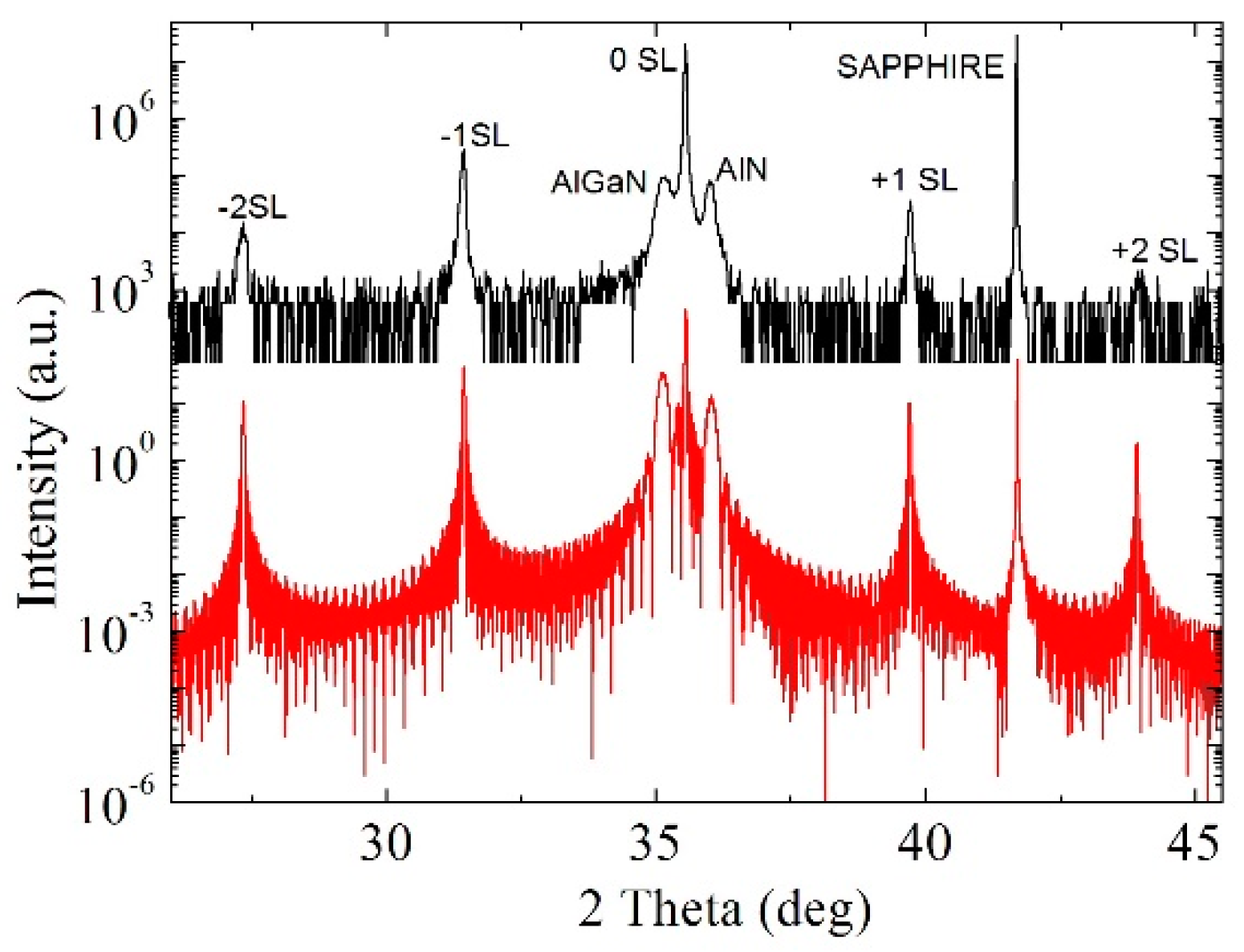
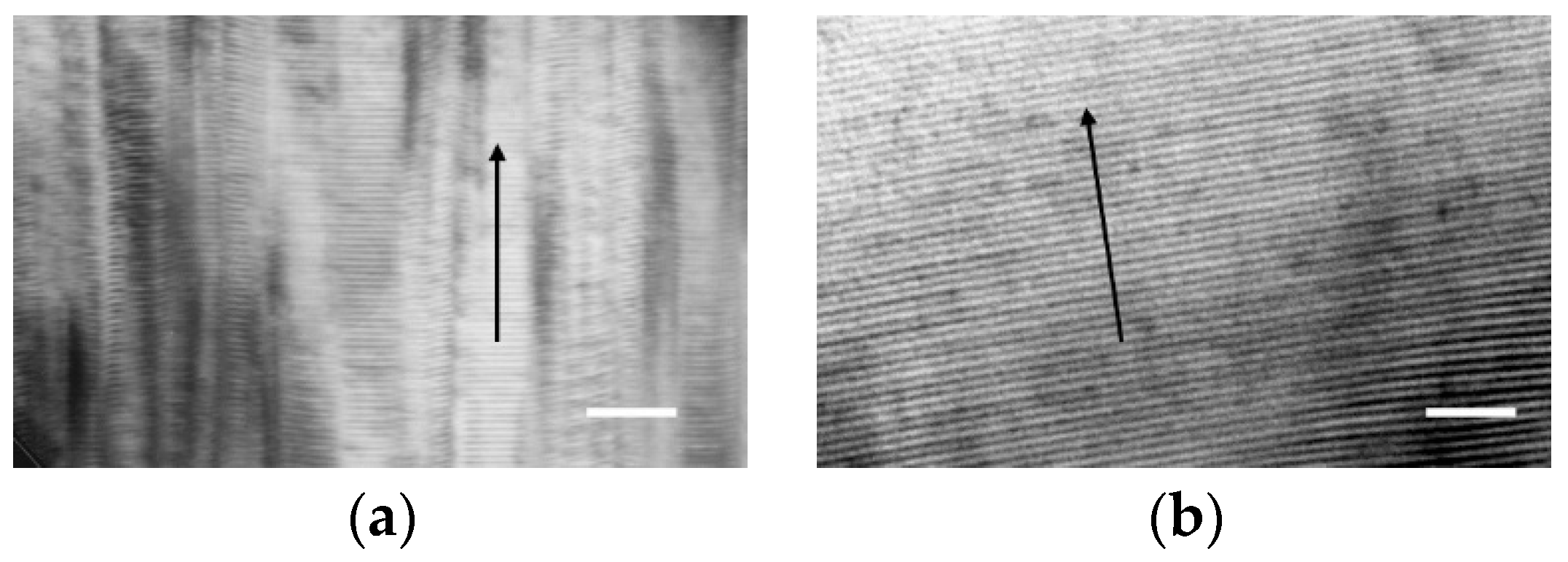
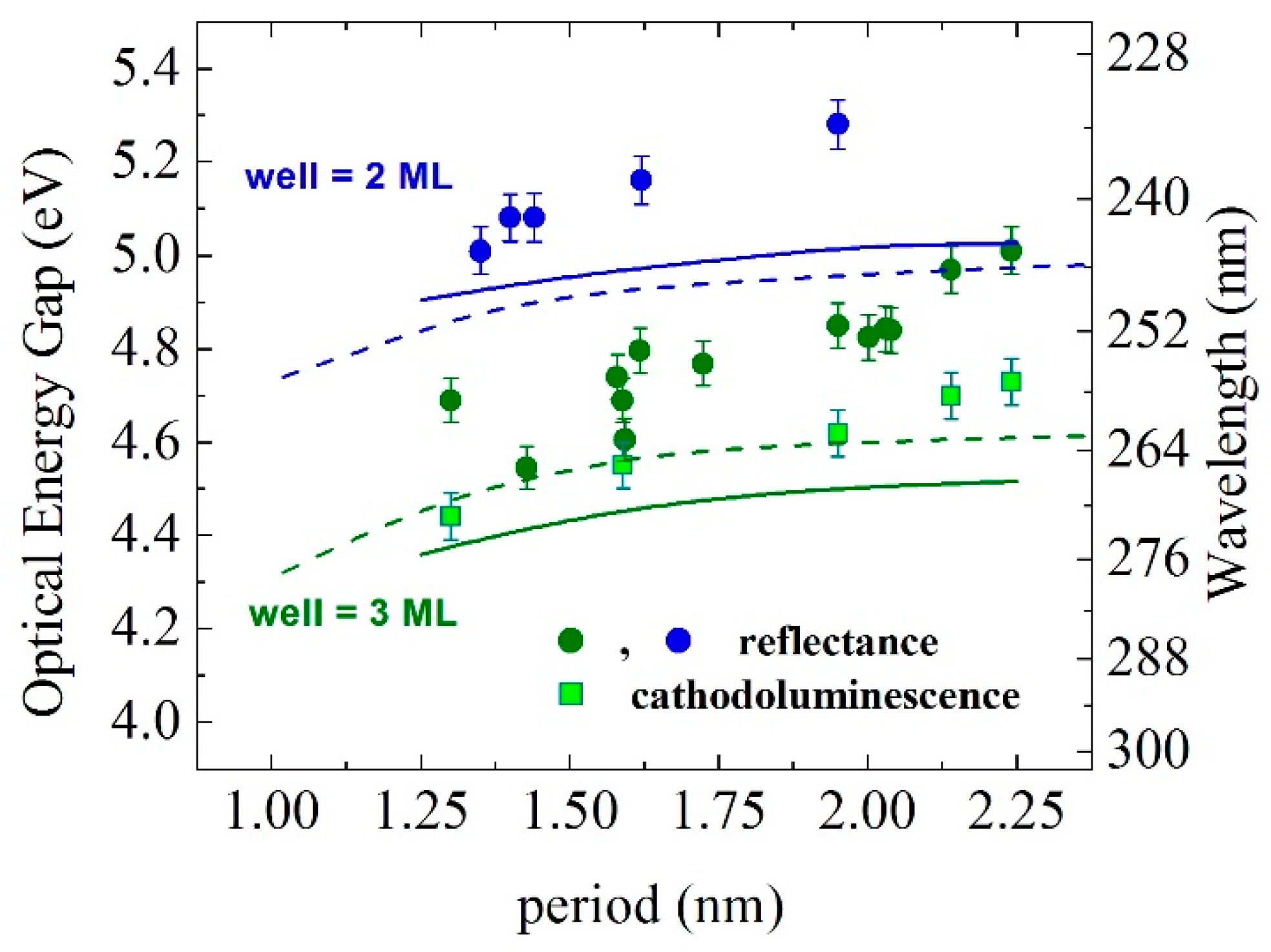
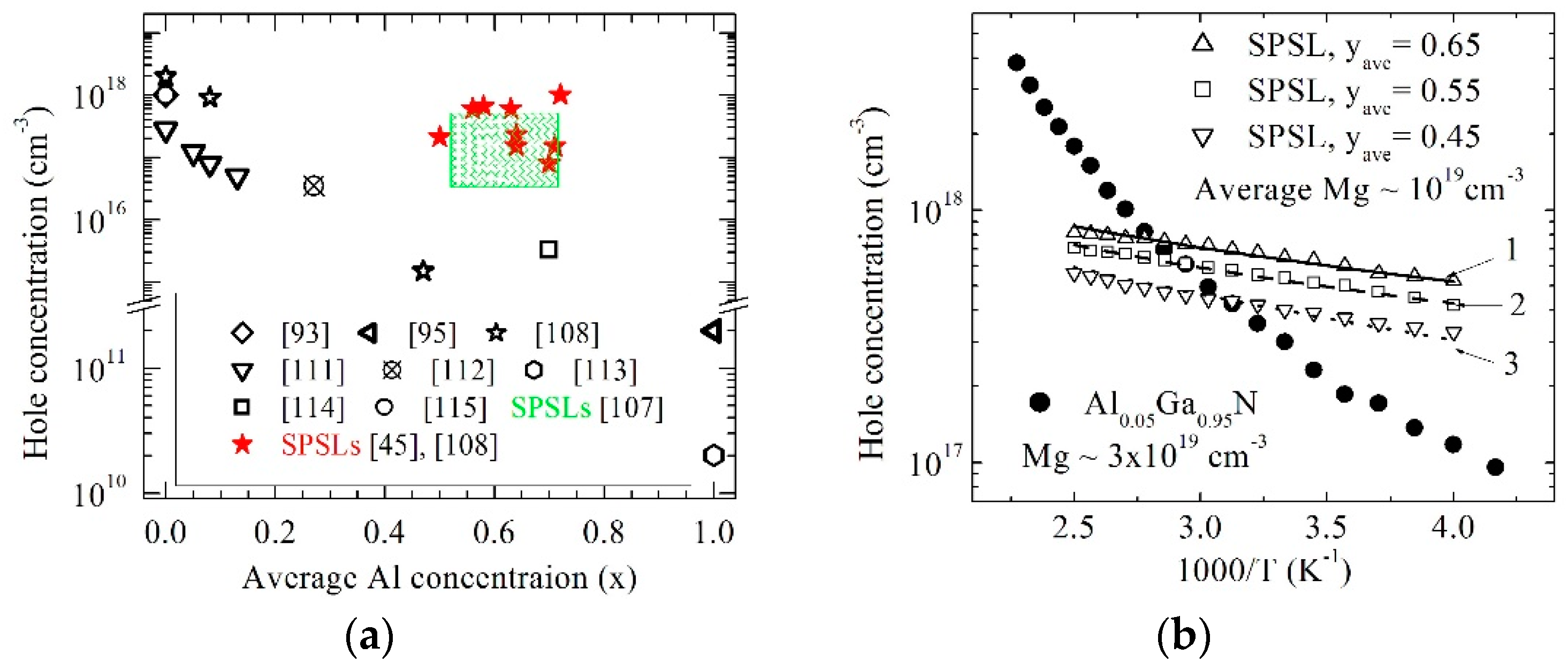
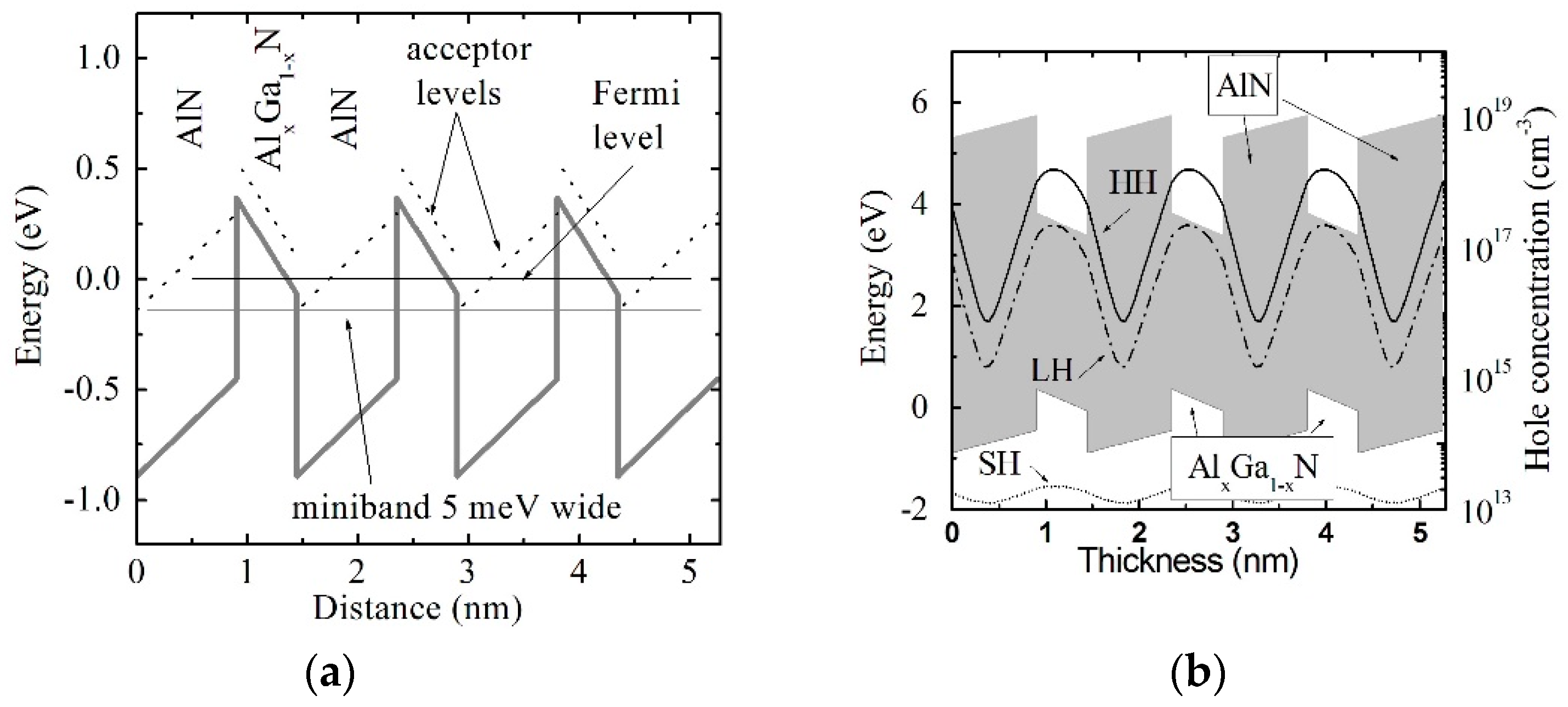
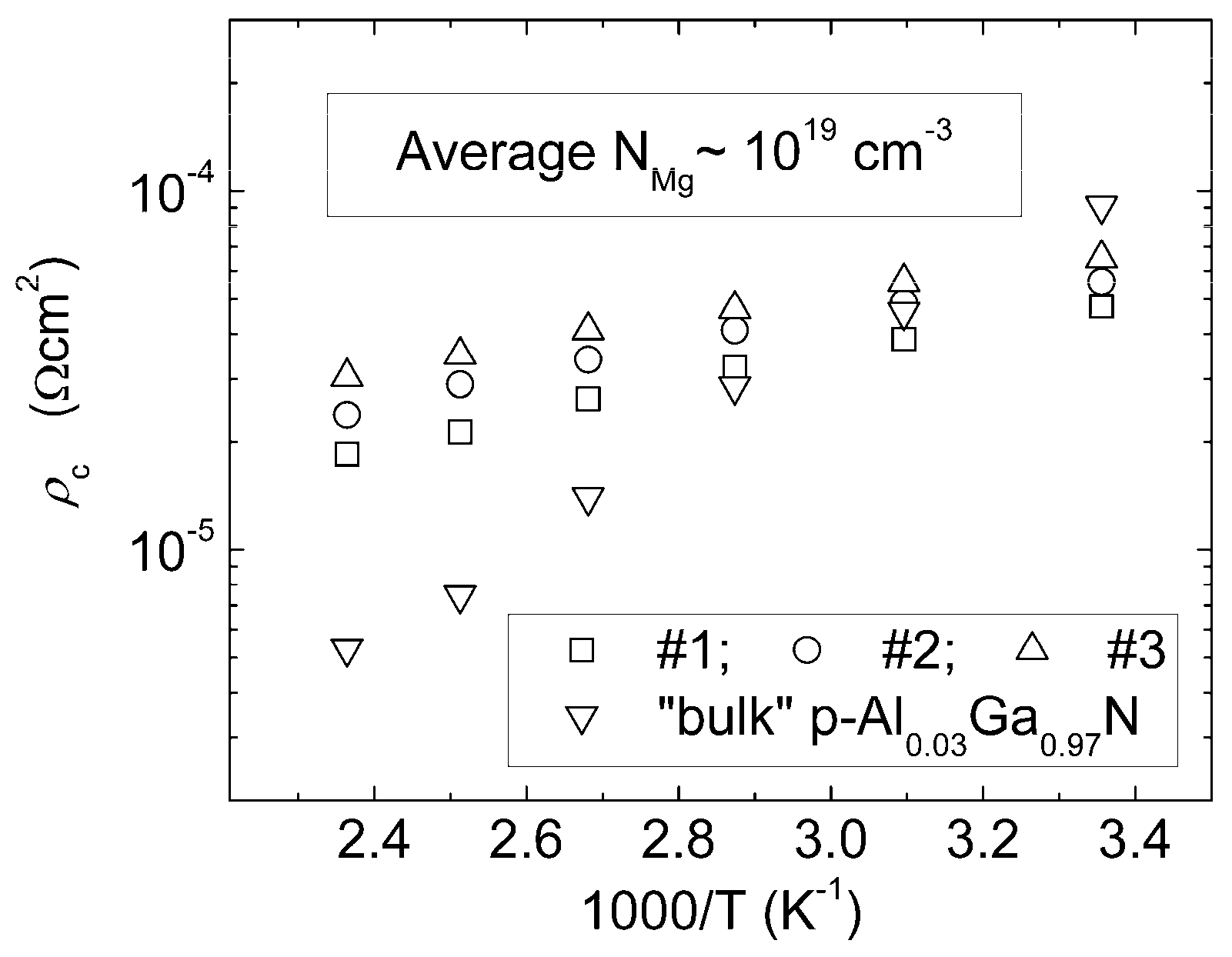
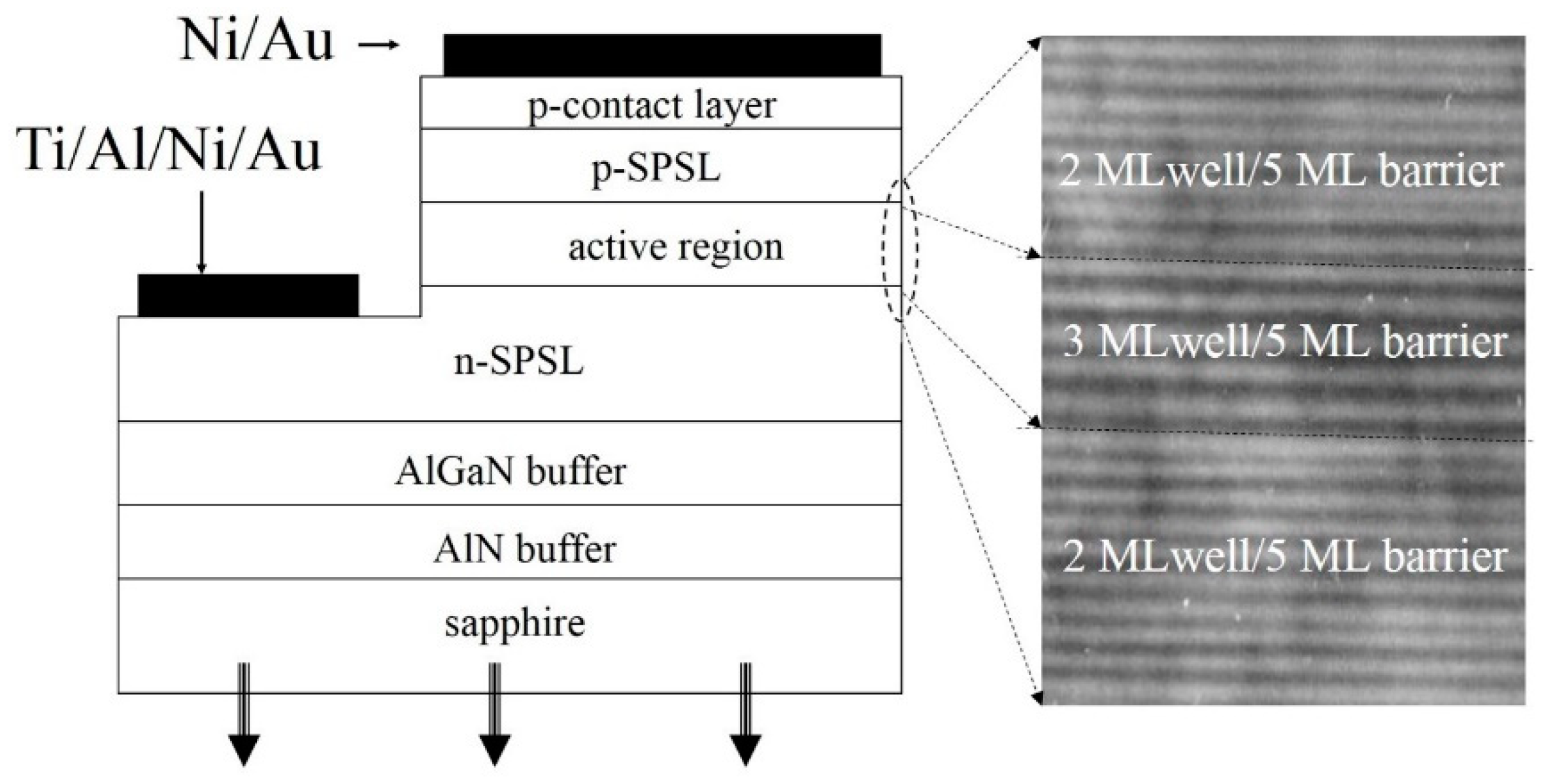
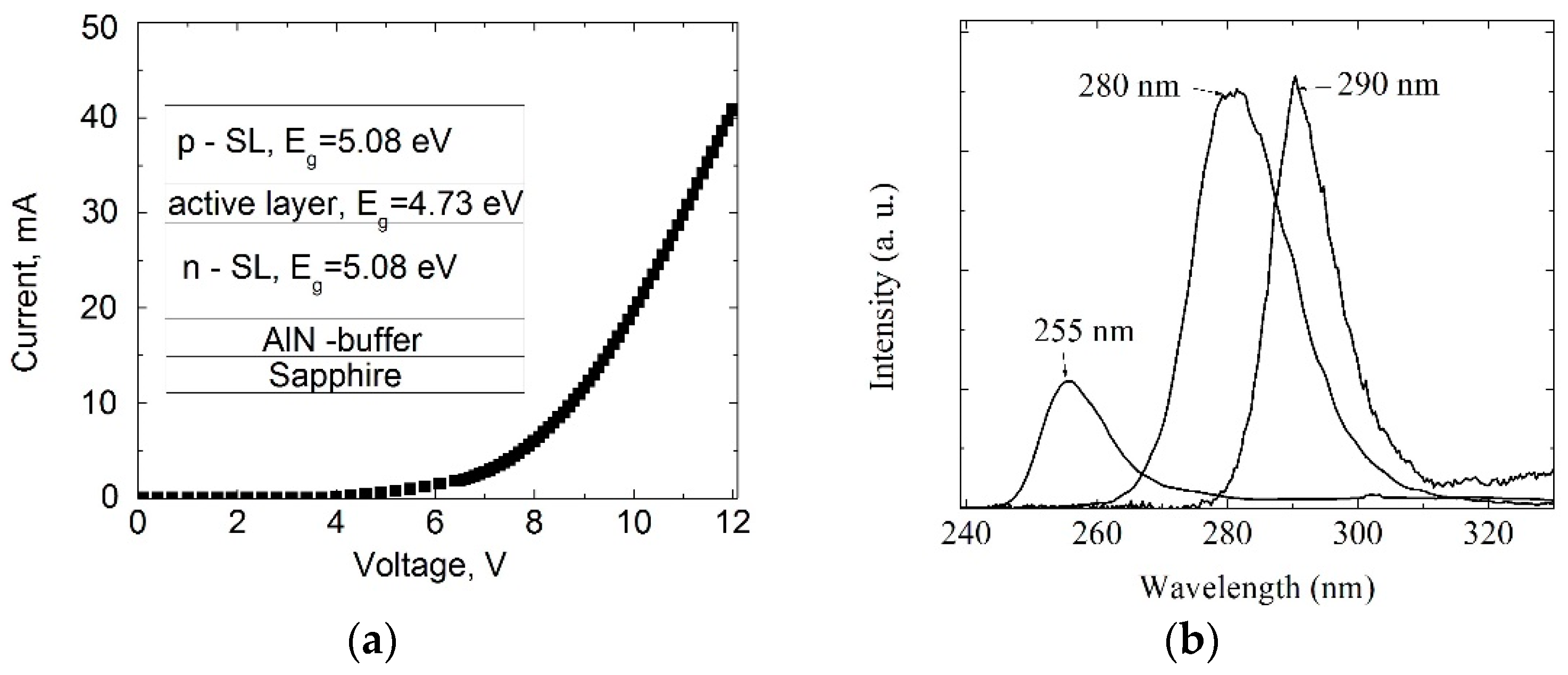
© 2018 by the author. Licensee MDPI, Basel, Switzerland. This article is an open access article distributed under the terms and conditions of the Creative Commons Attribution (CC BY) license (http://creativecommons.org/licenses/by/4.0/).
Share and Cite
Nikishin, S.A. III-Nitride Short Period Superlattices for Deep UV Light Emitters. Appl. Sci. 2018, 8, 2362. https://doi.org/10.3390/app8122362
Nikishin SA. III-Nitride Short Period Superlattices for Deep UV Light Emitters. Applied Sciences. 2018; 8(12):2362. https://doi.org/10.3390/app8122362
Chicago/Turabian StyleNikishin, Sergey A. 2018. "III-Nitride Short Period Superlattices for Deep UV Light Emitters" Applied Sciences 8, no. 12: 2362. https://doi.org/10.3390/app8122362
APA StyleNikishin, S. A. (2018). III-Nitride Short Period Superlattices for Deep UV Light Emitters. Applied Sciences, 8(12), 2362. https://doi.org/10.3390/app8122362



